
Ready to install artificial grass? If you want your lawn to look professional, have proper drainage, and last you for the next twenty-five years, our installation guide can easily show you how to prepare the subbase, trim and fasten the turf, add an infill, avoid wrinkling, and make sure your surface is clean and ready to go. Synthetic turf is easy to install, and with a few tips and tricks from professional installers, you can achieve the best results. Benefits: the list of installation tools, materials, and accessories, do-it-yourself videos, and more.

For a flawless and professional-looking artificial turf installation that boasts excellent drainage and durability for up to twenty years, it's essential to follow our comprehensive 12-step guide meticulously. Discover the complete list of necessary tools for the project at the bottom of this page. Plus, enhance your installation knowledge with our four detailed videos hosted by Dave, who expertly explains and demonstrates each crucial phase of the synthetic grass installation process. This guide ensures your artificial lawn not only looks stunning but also stands the test of time.
CAUTION: Turf should be rolled out under the sun with blades facing down at least 1-2 hours before installation. This will allow the turf to acclimate and, as a result, make, it easier to work with.
Note: Be sure the seams are taut and precise, the grain of the turf is facing in the same direction, and the space at the seam is the same as the stitching gauge.
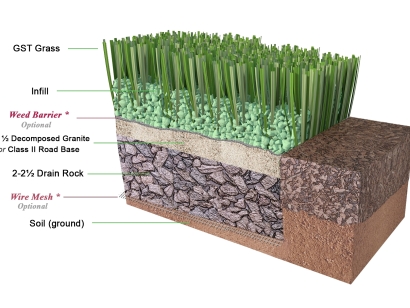
Almost all required tools can be found in your garage, except maybe carpet stretcher. A carpet stretcher is very useful when installing artificial turf. Specifically, you need it before you start seaming the edges of the lawn.
The second installation video shows how to use the stretcher. As a tip, the carpet stretcher is also called a knee-kicker. You strike the padded end with your knee. Wrinkles on the seam stretch nicely. A simple carpet stretcher from Home Depot will do. Don't want your turf to buckle? Use the stretcher.


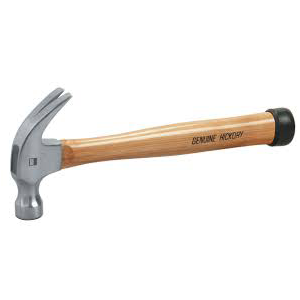









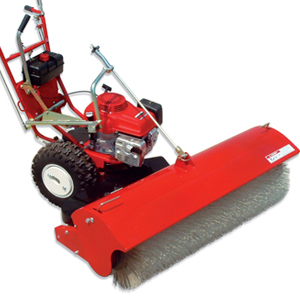

If you don't have a plate compactor, rent one for a day or two. Your base must be stable and well-compressed before you lay turf or pavers on top of it. If you don't compact your base well, it will continue to shift and compress in time, causing ruts in your lawn and developing higher or lower areas that eventually will cause buckles and wrinkles in the turf as well.
When you compact your base with a plate compactor, constantly water the area with a hose. Compaction is a straightforward process, but it takes time and patience to go over the area multiple times. Some say three to four times is good enough, but to be safe, repeat the go-round compaction procedure up to ten-twelve times before introducing the sub-base material. Don't forget to create a little slop in the area for proper drainage.


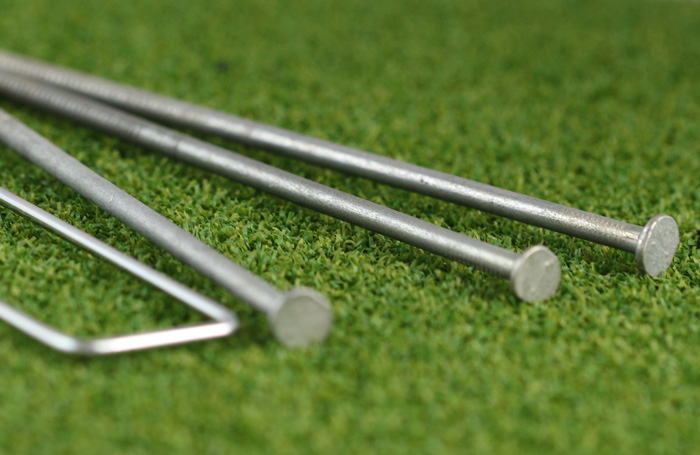

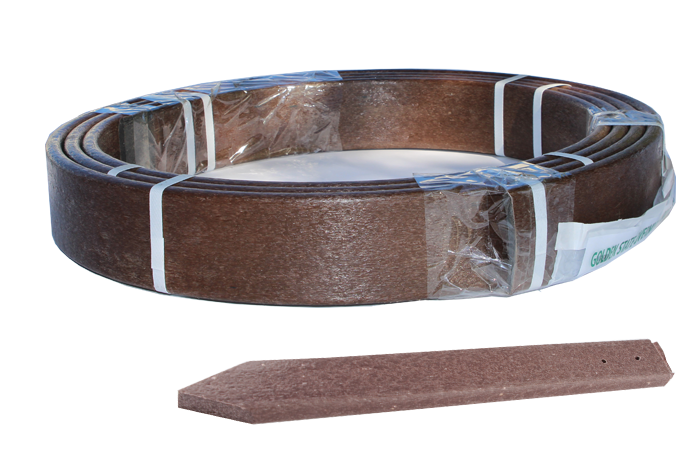
As you can see on the diagram above, a wire mesh is installed on top of the soil, after you removed dirt and existing sod, and before you start spreading and compacting drain rocks and decomposed granite. A Wire Mesh, or a wire barrier, is meant to prevent gophers and moles from damaging lawns. Are those critters populated in your area? Then, no matter what type of lawn you install, natural or artificial, you want to protect it. There are special "gopher wires" that are made specifically for this reason - to make a robust underground barrier below the surface of your lawn. This step is optional. Some regions have no issues with gophers, while in others, gophers' over-population affects the whole gardening and landscaping experience. Gophers love to tunnel their way up your lawn and to turn it into their salad bar. They are not too interested in artificial turf with rocks and granite underneath. If there are no problems with gophers and moles in your installation area, a wire mesh can be an unreasonable expense.
Amount of infill: Multiply 1/2 of pile height by the total number of square foot x 0.083333 x infill weight per cubic feet. It equals the infill weight in pounds.
For example, Super Natural 60 will take: pile height 0.1475' (1.77'') x 1,000 sq.ft. area x 0.083333 x 96.01 (pounds per cubic foot) = 1,180 pounds of silica sand, or 10 bags 100 lbs each, or 118 pounds per square foot.
Synthetic grass installation can take from 5 to 12 hours on average to install on any small to average size lawn. We have an artificial lawn installed in Auburn, California in the beautiful Lake of the Pines community. The most important part of the synthetic turf installation is the base preparation. If your site is prepared correctly, spread, and well compacted with drain rock, road base, or decomposed granite, the second step (see the second video) is easy. You just need a pair of scissors, measuring tape, and a pair of strong hands to lay out the turf on the base, seam the seams, and fasten the turf down with staples or nails.
Almost all required tools can be found in your garage, except maybe carpet stretcher. A carpet stretcher is very useful when installing artificial turf. Specifically, you need it before you start seaming the edges of turf. If you'll watch the second installation video, you will see how to use the stretcher. As a tip, the carpet stretcher is also called a knee-kicker. You strike the padded end with your knee. Wrinkles on the seam stretch nicely. A simple carpet stretcher from Home Depot will do. Don't want your turf to buckle? Use the stretcher.
If you don't have a plate compactor, rent one for a day or two. Your base must be stable and well-compressed before you lay turf or pavers on top of it. If you don't compact your base well, it will continue to shift and compress in time, causing ruts in your lawn and developing higher or lower areas that eventually will cause buckles and wrinkles in turf as well.
When you compact your base with a plate compactor, constantly water the area with a hose. Compaction is a very simple process, but it takes time and patience to go over the area multiple times. Some say three to four times is good enough, but to be safe, repeat the go-round compaction procedure up to ten-twelve times before introducing the sub-base material. Don't forget to create a little slop in the area for proper drainage.
Synthetic grass lawn doesn't need mowing, watering, or a fertilizing to remain green year round. It's a perfect alternative to green grass for homeowners who aspire for low maintenance, no irrigation, no fading, drought tolerant realistic lush, resilient and durable green lawn that helps to conserve water and reduce water bills.
Forget the astroturf of the past; modern artificial lawns look and feel better than natural; ideal for any type of yards; looks great in the backyard, on a playground, a dog run, and a lifesaver for pets.
For commercial landscaping, municipalities, turf fields, play area or dog run, fake grass lawns mean no trimming, no edging, no weeding, lasting, unlimited foot traffic, saving water and minimal upkeep. For homeowners, a turf lawn is aesthetic, perfectly manicured, no mower expensive, no dead grass, no fertilizer, no pesticides, the neighbors envy, always green grass all year round that increases your property value. For pet owners, no muddy paws, no odors, water bill reductions best grass field for pets to play with life expectancy for up to 25 years.
You don't need to fertilize artificial lawns to keep them healthy.
Use a leaf blower to remove leaves and debris from the surfaces occasionally.
If you are using the TCool infill, follow instructions on the package.
Lawn installation can take from 8 to 12 hours to complete by a professional contractor, installer or a landscaper from start to finish. As a homeowner and a gardener, installing artificial surfacing is aka installing outdoor carpet, made of polypropylene, may take a little longer. Estimate your project costs with our online calculators.
Perfect lawn made of quality products will help you save water and has a natural look. Compared to a natural lawn, fake turf can be installed on bocce ball fields, soccer field, football field, sports turf, playground surfaces, residential properties, balconies, decking, patio, play areas, athletic fields, front yard, back yard, or walkways.
As the synthetic turf suppliers of environmentally friendly turfs in the United States, we offer an unmatched 15-year warranty on all our turf lawn products grasses. No water, no crumb rubber, golf putting greens. For dogs, and homeowners with pets, we offer durable, fully recyclable, budget-friendly, year-long green, field turf directly from our synthetic grass warehouse to make your new lawn look greener, and decrease water consumption.
 | Posted Jul 11 8:16 PM |
Nice product that looks and feels durable. I'm using it on top of some gravel to cover it, as I don't want my cats to use it as a bathroom anymore. Plus, it's easier to spot scorpions and other types of animals.
 | Posted Jul 11 6:42 PM |
Worked perfectly for what we needed in the garden to seal off the netting and keep pests out.
 | Posted Jul 11 6:40 PM |
These stake pins work very well for multiple uses. With 100 pieces, I can accomplish several projects in my soil, which consists of sand, clay, and surface loam. My current project is an azalea bed. The stakes are wide enough to secure an electric line under the concrete walkway, ensuring safety for both the line and people. They also help secure PVC water lines in the bed but not in the immediate area. When the project nears completion, I will use them to secure the weed block. The 12-inch length holds much better than the shorter stakes I used previously. Another advantage is that one side can be cut shorter if it extends over the edge of the footer. The shorter side can go to the top edge of the footer while the longer side goes deep outside of it.
 | Posted Jul 11 6:38 PM |
I'm planning on purchasing a couple more. I need to cover a 10x10 area in my backyard, and this was perfect.
 | Posted Jul 11 5:35 PM |
I love the way it looks in my backyard! There was an area that just wouldn't grow grass, so I laid it down there, and it looks beautiful even with the leaves falling from the tree on it. I can't believe it's not real grass. I'm so happy! 😂
 | Posted Jul 11 5:34 PM |
We live in a rental community where the backyard is all landscape rocks. Adding the turf gave our small backyard some green color and made it easier to walk on.